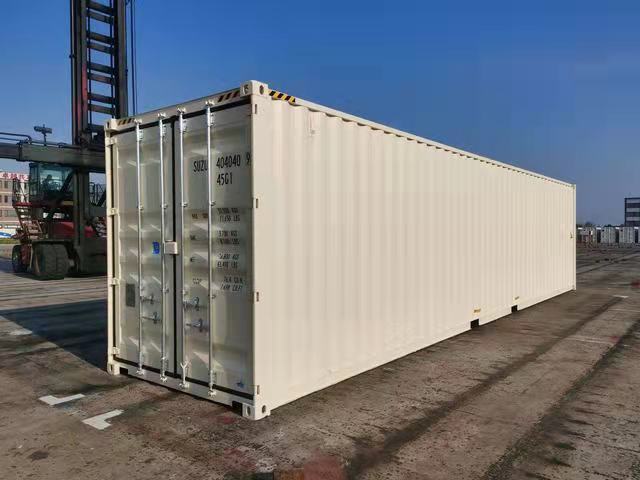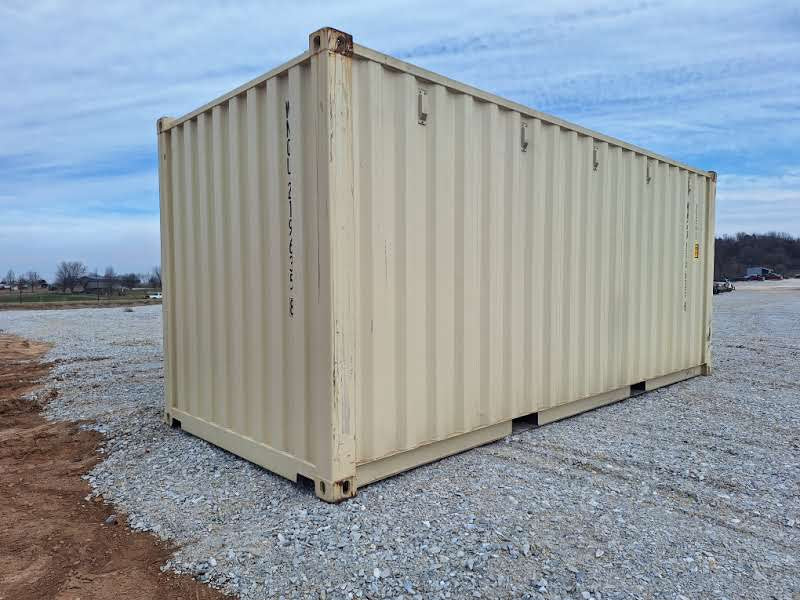5 Key Benefits When You Shop New Shipping Container 40 x 8 x 9.6 for Modern Living
5 Key Benefits When You Shop New Shipping Container 40 x 8 x 9.6 for Modern Living
Blog Article
The Ultimate Guide to Choosing the Right Delivery Container for Your Requirements
When it comes to picking the appropriate shipping container, understanding your specific demands is essential. You'll intend to think about factors like dimension, type, and product to ensure you make the very best selection. From basic dimensions to specialized choices, there's a great deal to discover. Plus, budgeting for both the container and any type of alterations can make a huge distinction. Allow's break down the key elements to aid you find the perfect fit for your needs.
Understanding Shipping Container Sizes
When you're picking a shipping container, understanding the various sizes offered is crucial for making the right choice. Delivering containers commonly are available in common lengths of 20 and 40 feet, however you'll likewise discover other measurements. Knowing the size you require depends on what you prepare to shop or transport.If you're relocating smaller sized things, a 20-foot container may be suitable, while larger deliveries often require a 40-foot container. The elevation can additionally differ; high dice containers provide added vertical space, which can be advantageous for taller goods.Before making a decision, determine your cargo, and think about how much room you'll require for loading and unloading. Always consider potential future requirements-- selecting a somewhat larger container might conserve you headache down the line. Inevitably, picking the appropriate dimension will certainly boost performance and assure your items are safe during transit
Types of Shipping Containers Available
There are several sorts of shipping containers available, each designed for certain purposes and freight needs. The standard completely dry container is flexible, best for basic freight. If you're shipping perishable goods, think about a refrigerated container, which maintains a controlled temperature level. For extra-large items, high cube containers use extra elevation, accommodating taller loads.If you require to transport heavy machinery or devices, flat shelf containers provide a tough base without walls. Open-top containers allow for simple loading of high freight, with a removable tarpaulin covering for defense. If you're seeking flexibility, take into consideration a retractable container that can be quickly kept when not in use.Lastly, specialized containers like container containers are utilized for liquids, while vented containers are developed for bulk freight that requires ventilation. Understanding your freight type will certainly assist you select the right container to satisfy your shipping needs effectively.
Material Considerations for Durability
When selecting a delivery container, the product plays a vital duty in its durability. You'll desire to evaluate the advantages of steel versus aluminum, specifically regarding deterioration resistance. Understanding these factors can aid you make a more educated option for your shipping needs.
Steel vs. Light weight aluminum Containers
Just how do you select between steel and light weight aluminum containers for your delivery needs? Start by thinking about longevity. Steel containers are durable and deal superb toughness, making them excellent for heavy loads and extreme problems. They withstand damage from impacts and are frequently less costly, which can be a major aspect for budget-conscious buyers.On the other hand, light weight aluminum containers are lightweight, which can conserve you on shipping prices. They're easier to navigate and are a fantastic selection if you require to transfer products often. Light weight aluminum is generally more costly and much less robust than steel. Evaluate your particular needs carefully, including weight, cost, and the kind of cargo you'll be delivery, to make the appropriate option for your situation.
Rust Resistance Factors
Selecting the ideal material does not just involve weight and expense; deterioration resistance plays a significant function in durability. When picking a shipping container, think about the atmosphere it'll deal with. Steel containers, while strong, can corrosion otherwise appropriately treated. Look for alternatives with protective finishes or galvanization to enhance their life-span. Aluminum, on the other hand, provides natural corrosion resistance, making it excellent for seaside areas or humid conditions. Nevertheless, it can be much more pricey. Additionally, evaluate the container's usage-- if it'll be exposed to chemicals or rough weather condition, focus on products that can endure these problems. Purchasing a corrosion-resistant container now can save you from pricey fixings or substitutes down the line. Choose carefully for long-lasting advantages.
Alterations and Modification Options
Shipping containers aren't just for delivering products; they can be transformed to meet your specific demands via various alterations and personalization options. You can convert a basic container into a relaxing workplace area, a momentary retail store, or perhaps an individual fitness center. The possibilities are nearly endless.Think about adding windows, insulation, or ventilation to enhance convenience. You could additionally think about electric circuitry, pipes, or even custom-made shelving to boost performance. If protection's a problem, strengthened locks can supply peace of mind.For aesthetic appeal, you can paint the container or add a distinct design to make it stand apart. Do not forget floor covering alternatives-- whether you want long lasting plywood or something more sophisticated, it can elevate the space.Ultimately, customizing your delivery container to suit your demands can boost functionality and create a special environment that mirrors your style.
Evaluating Your Transportation Needs
When it involves utilizing your modified delivery container, understanding your transportation requires is key. Begin by identifying what you'll be delivery-- whether it's hefty tools, retail goods, or personal products. Each kind of go cargo has different needs concerning dimension, weight, and accessibility.Next, take into consideration the range and mode of transportation. Are you delivering in your area, across the country, or globally? This affects the container's design and functionality. If you're using trucks, guarantee your container fits conventional measurements for easy loading and unloading.Additionally, believe about transportation conditions. Will your things need special security from weather condition or temperature level changes? If so, you could require insulation or ventilation features in your container.Lastly, evaluate exactly how typically you'll be moving goods. Constant deliveries may need a much more resilient and functional container to meet continuous demands. By dealing with these factors, you'll be well-prepared to choose the appropriate delivery container for your demands.
Budgeting for Your Shipping Container
Establishing a spending plan for your delivery container is necessary for ensuring a smooth buying process. Identify just how much you can afford to invest. Prices can differ substantially based on dimension, condition, and kind. New containers commonly set you back more, but made use of ones can use significant savings.Next, consider any type of extra expenses you might incur, such as transport fees, delivery costs, and adjustments. If you plan to personalize the container, element in those expenditures too. Research study various suppliers to contrast rates and find the very best offer that meets your needs.Don' t neglect to consist of any authorizations or policies that may apply to your acquisition and usage of the container. By clearly detailing your budget, you'll be better prepared to make informed choices, guaranteeing you get the appropriate container without damaging the bank.
Upkeep and Look After Durability
To ensure your shipping container lasts for several years, regular upkeep is vital. Beginning by examining the outside for corrosion, damages, and damages. If you detect any problems, resolve them quickly to prevent more degeneration. Tidy the container regularly, both in and out, to remove dust, debris, and moisture that can result in corrosion.Ensure the doors seal effectively and lubricate the hinges to prevent rust and sticking. If you're utilizing the container for storage, think about adding ventilation to lower moisture and mold and mildew development. For added security, use a rust-inhibiting paint or sealer annually.If your container's located in a severe atmosphere, like seaside locations, you could need to boost upkeep regularity. More hints Watch on the flooring, as well; any signs of wear should be repaired as soon as possible. With these basic actions, you'll expand the life of your shipping container considerably.
Regularly Asked Questions
Just how Do I Locate a Reliable Delivery Container Supplier?
To find a trustworthy delivery container distributor, beginning by investigating online evaluations, asking for referrals from buddies or market contacts, and contrasting rates. Always examine their qualifications and guarantee they offer top quality containers that satisfy your demands.

Can I Lease a Delivery Container Instead of Acquiring?
Yes, you can certainly rent out a check my blog delivery container rather of purchasing one. Numerous vendors use rental options, which can save you cash and give versatility if you only need it for a short duration.
What Allows Are Needed for Container Positioning?

Are Delivery Containers Weatherproof and Suitable for Outdoor Storage?
Yes, delivering containers are normally weatherproof, designed to hold up against rough conditions. Their durable building and construction keeps your things protected and completely dry, making them suitable for exterior storage space. Simply ensure proper ventilation to avoid wetness accumulation inside.
How Do I Transfer a Shipping Container Once Bought?

Report this page